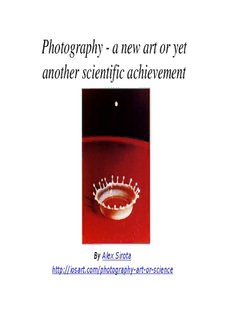
Photography - Art or Science - Alex Sirota's Home on the Web PDF
Preview Photography - Art or Science - Alex Sirota's Home on the Web
Photography - a new art or yet another scientific achievement By Alex Sirota http://iosart.com/photography-art-or-science Contents • Part I - History of Photography • Camera Obscura • Reflex Mirror • Optical Glass and Lenses • Part II - Technology of Photography • Light Sensitive Materials • Daguerreotypes • Roll Film • Color • Digital Photography • Part III - Photography as Art • Pictorialism and Impressionism • Naturalism • Straight Photography • New Vision of the 20th Century • Part IV - Photographic Techniques • Stereoscopic Photography • Infrared Photography • Panoramic Photography • Astrophotography • Pinhole Photography Part I History of Photography Photography The word “photography” which is derived from the Greek words for “light” and “writing”, was first used by Sir John Herschel in 1839, the year the invention of the photographic process was made public. L.J.M Daguerre, "The Louvre from the Left Bank of the Seine” daguerreotype,1839 Scientific Discoveries • The basics of optics - Camera Obscura • Optical glass • Chemical developments - light sensitive materials • Digital Photography Leonardo Da Vinci, The Magic Lantern, 1515 Camera Obscura Camera obscura - Latin, camera - chamber, obscura - dark A dark box or room with a hole in one end. If the hole is small enough, an inverted image can be seen on the opposite wall. Reflex Camera Obscura, Johannes Zahn, 1685 Camera Obscura - Ancient Times • China, Mo Ti (470-391 B.C.) • Greece, Aristotle (384-322 B.C.) • • Egypt, Alhazen (965-1039 A.D.) Chinese texts • The basic optical principles of the pinhole are commented on in Chinese texts from the 5th century B.C. • Chinese writers had discovered by experiments that light travels in straight lines. • The philosopher Mo Ti (470-391 B.C.) was the first to record the formation of an inverted image with a pinhole or screen. • Mo Ti was aware that objects reflect light in all directions, and that rays from the top of an object, when passing through a hole, will produce the lower part of an image. Aristotle’s observations • Greek philosopher and scientist Aristotle (384-322 B.C.) comments on pinhole image formation in his work “Problems”. • He asks his readers: "Why is it that an eclipse of the sun, if one looks at it through a sieve or through leaves, such as a plane-tree or other broadleaved tree, or if one joins the fingers of one hand over the fingers of the other, the rays are crescent-shaped where they reach the earth? Is it for the same reason as that when light shines through a rectangular peep-hole, it appears circular in the form of a cone?” • Aristotle found no satisfactory explanations to his observation and the problem remained unresolved until the 16th century. Alhazen’s experiments • Arabian physicist and mathematician Ibn Al-Haitam (965-1039 A.D.), also known as Alhazen, experimented with images seen through the pinhole. • He arranged three candles in a row and put a screen with a small hole between the candles and the wall. He noted that images were formed only by means of small holes and that the candle to the right made an image to the left on the wall. • From his observations he deduced the linearity of light. He also described how to view a solar eclipse using a camera obscura and was the first scientist to make this observation.
Description: